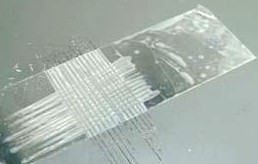Refer to National Standard ASTM D3359 "Standard Test Methods for Rating Adhesion by Tape Test"
Use a sharp blade with a cutting edge angle of 20-30 degrees to form a lattice pattern of 10 × 10 squares, each 1mm × 1mm, on the test sample surface. Each cut should have a sufficient depth to reach the bottom layer of the paint. Clean up the test area by dusting the debris off with a brush. Firmly attach tape with an adhesion strength of 350 g/cm² to 400 g/cm² to the test grid using adhesive tape such as 3M 600 or equivalent. Massage the tape with an eraser to increase the contact area and force between the tape and the test area. Grasp one end of the tape and quickly remove it at a 90° angle. Repeat the test at exactly the same position twice. After testing, the removed paint shall be examined with 5 times magnifying glass.
Results Determination:

Cross-hatch adhesion testers / probador de adhesión de corte en cruz
The adhesion is considered acceptable if ≥ 4B.
5B: The edges of the cuts are smooth; no paint removal is present at the edges or at the intersections of the cuts.
4B: Small areas of paint are removed at the intersections of the cuts; the total removal area is less than 5%.
3B: Just minor areas of paint are removed at edges and intersections of cuts; the total area of removal is between 5% and 15%.
2B: Large areas of paint are removed at edges and intersections of cuts; the total area of removal is between 15% and 35%.
1B: The edges and intersections of cuts reveal large areas of paint removed with an overall total removal area between 35% to 65%.
0B: The edges and intersections of cuts reveal large areas of paint removed with an overall total removal area greater than 65%.
Note: No areas of paint should readily peel off of the edges or corners of the coating when scratched with a fingernail.
